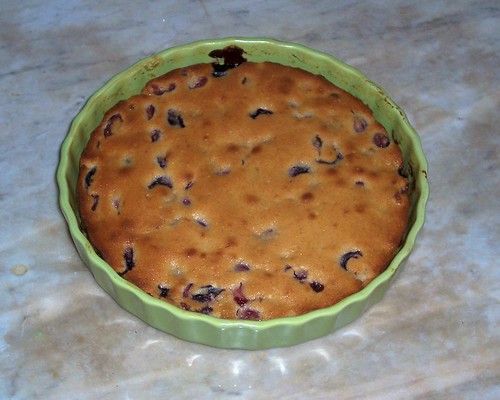I was, instead, thinking of what to do with two pints of cherries I'd bought at the farmer's market: one of the last of the season's tiny sour pie cherries and another of sweet bing cherries.
I was not in the mood to deal with pie crust. I thought of making a clafoutis, a cherry dessert from the Limousin region of France. I even went so far as to research recipes for clafoutis (of which there are many on the web and in books, in English and in French. I know for a fact that my high school French teacher is pleased and amused that I retain enough French to read recipes in it).
While looking at the clafoutis recipes, I found one which used griottines. No, I'd never heard of them either. A little more research revealed that griottines are morello cherries macerated in brandy. They are apparently sometimes found in small jars with large price tags at gourmet groceries. The name griottine is also applied to an apéritif made and consumed in the valley of the Semois in northern France, which is derived -- you guessed it -- from morello cherries. And griotte is French for morello cherry. It all comes clear now, doesn't it?
Somewhere during the detour through griottines, I got distracted and moved from clafoutis to cherry cakes. This was partly because most of the clafoutis recipes called for things I didn't have on hand and didn't feel like driving out to get. I was out of almonds. Marscapone seemed a suspicious ingredient in a French recipe.
I also remembered reading the lyrical discussion of homemade sweets in Joseph Wechsberg's The Cooking of Vienna's Empire.1 Wechberg's reminscences of the various cakes and puddings made by Marie, the Moravian woman who cooked for his family when he was a boy, are especially well-drawn. In particular I was struck by a story of Marie's injured dignity when Wechsberg's mother presented the cook with a recipe for a cherry cake that she had inherited from an aunt -- 'But, gracious lady, what is wrong with my cherry cake?' Mrs Wechsberg wisely never brought up her aunt's recipe again.
Sadly for us, the recipes in the book were compiled entirely by a Time-Life editorial team and they did not see fit to include any recipes for cherry cakes as made in early 20th century Moravia. (Though to be fair, they did come up with a good variety of classic recipes, any one of which is worth trying. The Viking has cluttered up my copy with sticky notes marking things he'd like me to make).
So, with thoughts of griottines and other homemade sweets, I made this

Ingredients:
2 cups (sour) cherries
2 tbs brandy
1/2 c (1/4 pound, 1 stick) butter, softened
1 c sugar + 1 tbs for cherries
2 eggs
1 1/4 cup flour (all purpose, but see note)
1/2 tsp salt
1 tsp cinnamon
1/2 tsp nutmeg
1/2 c milk
Nota bene: I did not add any leavening to this and it came out fine, though the effect was somewhat coffee cake-ish. If one prefers a little more pouf in one's cake, 1 tsp of baking powder could be added, or self-raising flour substituted.
1. Pit the cherries and put them into a glass bowl. Sprinkle them with 1 tbs sugar and 2 tbs brandy. Cover the bowl and leave in a cool place (or in the refrigerator) several hours. (I pitted my cherries in the morning and made the cake at dinnertime. You could leave them to soak longer. You could probably also use store-bought frozen cherries, but you'd want them to be thawed completely before folding them into the batter).
2. Preheat the oven to 350 F. Butter a 9" square or round baking dish (I used a round Chantal Bakeware quiche dish. I love that thing).
3. Cream butter and sugar together until smooth. Beat in the eggs one at a time. The adventurous might add a tsp of vanilla or almond extract.
4. Sift together the flour, spices and salt (and baking powder) in a small bowl. Beat the flour mixture into the butter alternately with the milk.
5. Fold in the cherries, draining off as much liquid as you can. (My 2 pints of cherries left me with about 3 cups of prepared cherries -- I froze the extra cup of cherries with the juice for some future use).
6. Pour the batter into the buttered pan and bake for 30-35 minutes, or until golden brown on top and a tester comes out clean. Serve warm.
In a perfect universe, I'd have a photo of a slice of the cake beautifully plated, with a dollop of whipped cream and perhaps a few mint leaves as garnish, and a silver fork as a prop so you could see how lovely the cherries looked distributed through the cake. This is not a perfect universe, and anyway the cake didn't last that long. You'll have to take my word for it.
1This book is from the Time-Life Foods of the World series, published in the late 1960s. Notwithstanding its presence in a Time-Life series, The Cooking of Vienna's Empire is a minor culinary masterpiece; I read about it in a piece in the Times in February 2006 and subsequently bought it. I also picked up the volume on Scandinavian food. The Cooking of Scandinavia, by Dale Brown, is not quite in the same class as Wechsberg's book, but has an incomparable series of photographs of Max von Sydow, c. 1968, demonstrating the proper technique for toasting your companion with aquavit. Skol!

No comments:
Post a Comment